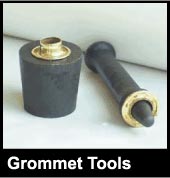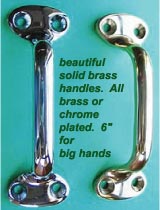
 Custom Search
|
| sails |
| plans |
| epoxy |
| rope/line |
| hardware |
| canoe/kayak |
| sailmaking |
| materials |
| models |
| media |
| tools |
| gear |
| join |
| home |
| indexes |
| classifieds |
| calendar |
| archives |
| about |
| links |
| Join Duckworks Get free newsletter CLICK HERE |
|
|
| Poke About XL - A Letter to Ken Simpson |
by Richard Atkinson
- Brisbane, Queensland - Australia |
| With an introduction by Ken Simpson, Designer. Hello Chuck, This letter is from Richard Atkinson of Australia, and it is about his build of the Poke About XL, his first ever boat construction. What's interesting is that he takes long trips in this small trolling motor powered boat, down busy Australian rivers, and prepares meals on board, enjoying every moment. There are no photos of the building process, but there are good ones of the finished boat, and some of the places he has traveled. Best regards, Ken Simpson
A Letter to Ken SimpsonDear Ken, My name is Richard Atkinson and I live in Brisbane, Australia in the suburb of Jamboree Heights. I bought the plans for the Poke About from Duckworks in late 2011. I chose the XL version to build. I launched it late last year into the Brisbane River.
This was my maiden voyage. I had never built a boat before in my life and boy was I ever wrapped when I launched it. I could have bought a boat at any time in the past but I felt that would spoil the experience of making a boat and seeing it actually float. I decided to just leave it varnished and not paint it any other colour. The weight of the hull is 48 Kilograms (105.5 lbs). I transport my boat on the top of my car.
I have been doing trips on it in the Brisbane River. From the ramp near me to the mouth of the river, the distance is 33 miles because it is a serpentine river. In short lengths, I have travelled continuous along the river from upstream to the mouth, for a distance of 41 miles. The total voyage distance I have done in this boat from trips so far is 146 miles. I use two deep cycle batteries. A 80 AH and a 120 AH. Total weight of these batts is 48 Kg, same as the hull. I have to go with the tidal current in the river. I have encountered currents at a speed of 1 to 2 mph. I use a Minn Kota outboard. It gives a cruising speed of 2 mph at number 4 speed. It takes 19.3 amps from the battery at this setting and this amounts to about 240 watts, 1/3 HP. The max number 5 and is stated to give 45 lbs push at this. The boat goes 3 mph at 5. It consumes 40 amps at this setting and is about 500 watts. The most economical is 1 and it consumes 8 amps, giving a speed of 1 mph. At 3 mph, the bow moves up a little. When I row, the boat goes 1 1/2 mph. If I try harder, I am in danger of breaking the plastic claw of the rowlock (a weakly made type). I haven’t installed the pontoons on the rear yet. I thought I might want to make them a bit longer and have the top part horizontal to make extra space to store something. I hope adding these will improve the hydrodynamic drag characteristics. This State of Queensland passed a law that home made boats have to have a hull number. It takes a certain amount of effort and expense to get a hull number. This does not apply to boats that are powered by an engine of no more than 4 horse power or carry no more than 2 people (and I suppose the HP would have to be less than 4). This requirement also does not apply to a sail boat also. I am glad that I don’t have to get myself a hull number. If the hull has to have a number, it also has to have a plate stating the maximum load and number of people that can be on board. Also, there has to be a duplicate plate placed in a concealed place. People had been doing silly things in the past, overloading boats and getting themselves killed. You can read more about this at the Maritime Safety Website. The Brisbane River is very scenic. I’d like to include some photos from trips I have done:
Because I have to go with the tide to get there and back home, I have to consume the time that it takes for the tide to turn. This results in a long trip and takes me into the night for long periods so I bring a meal and tea/coffee making facilities with me. I have cooked a full barbecue on board the boat a number of times using a cartridge gas stove and frypan. That is alright. More time having fun, boating. I put up the required all round white navigation light one meter above the boat. There are not many people on the river late at night so I have it all to myself. It is necessary to watch out for logs and tree branch debris on the river. I have a light at the front to see these. The city lights is pretty good for this too or the moon or reflected city light coming off the clouds is useful in the more country areas. I’ll probably be tempted to get a petrol motor outboard eventually. We do have a dam in the country area called Wivenhoe Dam. This is almost the size of an inland sea. The laws state that an electric outboard must be used in a boat on this particular Dam. To load the boat onto my car, I slant it from vertical onto a board that protects the car at roof rack level. This board is the improved version and you can’t see this in the photo. I tip it up onto the racks using counter balance then twist it around on the racks. To take the boat to the ramp and down into the water, I place trolleys underneath it at counterbalance location. I take it with all the gear loaded in. The latest version of the trolley allows me to do this as well as wheel it directly into the water. Then I reach underneath and retrieve the trolleys, putting them inside the boat. The pine wood allows the trolleys to float up to the bottom of the boat. I will attach cords to the trolleys and fix the other end at the front bow handle. This will stop them from moving out of place when I haul the boat over ground when some roughness causes resistance.
The two trolleys above enable the boat to ride over the channels in the ramp. I will attach cords to them as I said. The one on the right is previous version. It fitted between the drifters at counterbalance location. That cord wrapped around the boat and held the trolley in place. The boat bump bumped when it went over the channels in the ramp. It had to be done with the boat empty. It was launched and the gear loaded into it. This boat incites a certain amount of awe in people when they see it. Just about every boat these days is commercially manufactured. Thank you for the design of this boat. I continue to think of boats, and what I will do next. Richard Plans for Poke About are in the Duckworks Store. Editor's Note: Living near the Brisbane River myself, Richard's adventures are extraordinary. I hope I see him on the water someday. Mike John |
|













